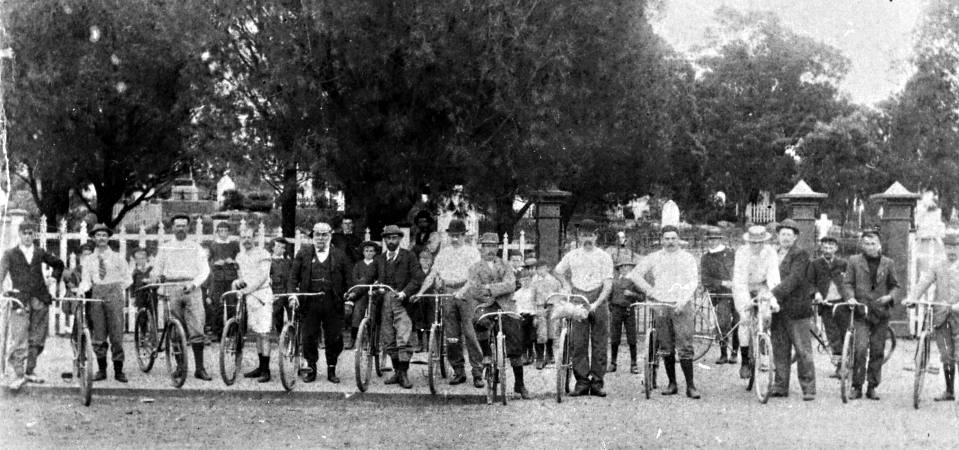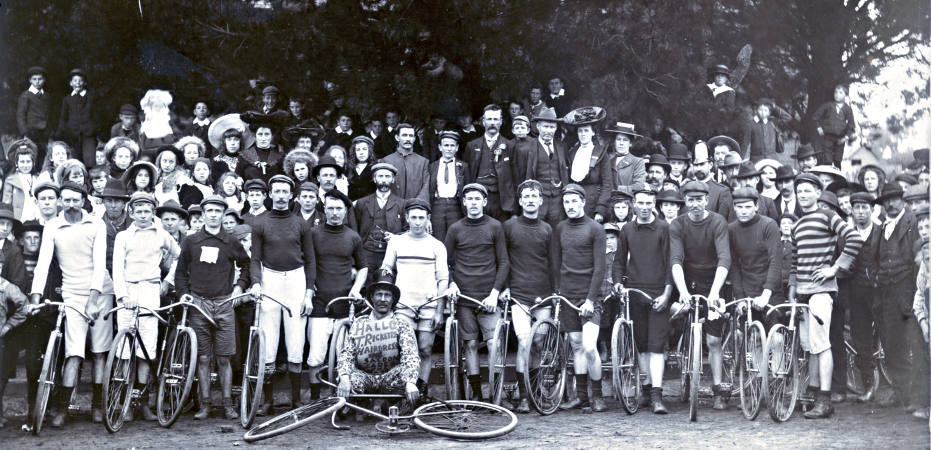Inspectors of Nuisances and Riding on Footpaths

Bicycle Riders outside the Cheltenham Cemetery waiting for the commencement of a weekly bike race. Photographer Percy Fairlam. Courtesy Betty Kuc.
Early in the establishment of the Shire of Moorabbin the council instituted a position called Inspector of Nuisances. The appointees to this role were responsible to see that the by-laws of the Shire were observed and respected by both its residents and visitors. Such positions were introduced in England in 1846 with the passing of the Nuisance Removal and Prevention Disease Act. Under this legislation towns were able to appoint inspectors to report on offensive conditions in their area. For some time, in the Shire of Moorabbin, this position was taken up by local constables as a paid addition to their regular police work of investigating murder, robberies and unruly behaviour.
One of the earliest inspector of nuisances in Moorabbin Shire was John Bodley not a policeman, but a council employee. In 1874 he was appointed as Rate Collector, Dog Inspector, Clerk of Works, Valuator and Collector of Statistics at a salary of £90 per annum. [1] In October 1882 he took on the additional responsibility of Inspector of Nuisances at the increased salary of £175. [2]
Six years later a series of appointments were made to this role but in these cases all were local constables. Constable Fergus of Cheltenham was appointed in May 1888 at a salary of £10 but with the added incentive of receiving half the fines the council received from any prosecutions he successfully brought to a conclusion. [3] This same incentive was not given to appointments made three months later to Constable Wilson of East Brighton, and Constable Glenny of Mordialloc. All received the addition of £10 per annum to their normal police salary. The same conditions applied to Constable Farnan who replaced Constable Glenny at Mordialloc and to Constable Manny of Mentone. Constables Patrick Mulcare and Hore were appointed in 1893 at the salary of £10. [4] A subsequent request of Constable Mulcare for £15 was rejected. [5]
These inspectors were engaged in prosecuting those who infringed the by-laws of the shire. This meant that inspectors were involved in court cases at Cheltenham, drawing the attention of the bench to offences involving inappropriate disposal of night soil, bathing in the open sea at Picnic Point and Mentone beaches, using offensive language, and to vagrants. In addition to these offences many individuals were taken to court for riding their bikes on footpaths.
In 1896 five individuals were fined at the Cheltenham Court for riding their bicycles on footpaths. [6] In all five cases the defendants pleaded guilty of a ‘technical offence’ and were fined a nominal amount. Inspector Butler, speaking to the members of the bench, pointed out that the practice of riding bicycles on footpaths in the shire was becoming very frequent and while he did not oppose the nominal fine on this occasion he hoped that in the future the court would impose fines which would act as a deterrent to the practice. In his view those persons infringing the law knew what they were doing. He pointed out that the council was determined to prosecute in all cases with the aim of doing away with the nuisance. [7]
The chairman of the court responded to Inspector Butler’s comments saying that the court would aid the shire council in its endeavours. He believed those cyclists who had been fined would inform their friends of the penalty imposed. Moreover, he indicated future offenders would not be treated so lightly given that the law allowed a fine of up to £20. [8]
The following months saw several cases before the court. In April David Brayshay was charged with riding his bicycle on a footpath in Cheltenham. He did not appear in court but wrote a letter in which he pleaded guilty. Constable Curtin conducting the prosecution had the assistance of several people. Mr Bodley, clerk of works at the Shire of Moorabbin, said the footpath had been constructed at a cost of £185, while Miss Hawkins and Messrs McGrath and Judd gave evidence to the fact that pedestrians were using the footpath at the time of the offence. John Butler informed the bench that the licensee of the Exchange Hotel had warned cyclists that afternoon against riding on the footpath. Brayshay was fined five shillings with twelve shillings and six pence costs. [9] In May, William Thomson, Thomas Dwyer and Leslie Smith were charged with the same offence but on this occasion the court imposed a fine of ten shillings with two shillings and six pence costs. This payment was in default of forty eight hours imprisonment. [10] Two later cases in December of the same year, Charles Alexander and D Williams, were each fined five shillings with two shillings six pence costs. Both Alexander and Williams were caught riding on the footpath in Centre Road, East Brighton. [11]
Prosecutions continued the next year. A cyclist pedalling on a footpath in Cheltenham had the ‘misfortune’ of meeting Inspector Butler and Constable Curtin. The constable threw his arms around the cyclist and both fell heavily. The cyclist landed in an acacia hedge and the skin was scraped from the constable’s shin. When questioned he gave his name as Edward Perry of High street Northcote, occupation, hairdresser. Later, after the summons was served, Perry’s solicitor informed the court that his client was not in Cheltenham on the day in question. As a result the summons was withdrawn and the constable took out a warrant against an unknown person for the offence. [12] A few months later the Justices of the Peace, Attenborough and Brown, imposed a fine of two shillings and six pence with an identical amount for costs on James Wilson and Henry Preston for a similar offence. Both admitted their guilt. [13]
A year later, Dr Weigall, a local medical practitioner, was fined for riding his bicycle on a footpath in Black Rock. There was no plea of mitigating circumstances and he was fined ten shilling with two shillings and six pence costs. [14] In that same year Harry Raisbeck was before the court for the same offence. He failed to stop when called upon to do so by Constable Westcott but that did not save him from prosecution. Given that he did not stop the court asked Constable Westcott how he ‘got him’. The constable replied that he was a neighbour. He explained that people were saying that he allowed Mentone people to ride on the footpath and to prove them wrong he summoned Harry Raisbeck. The newspaper report gave no indication of the penalty imposed. [15]

Cyclists gather for a club 24 mile race. Courtesy Len Le Page.
Over the next few years court reports of people being fined for riding on footpaths are few in number. The reasons for this are not clear. Perhaps people stopped the practice, perhaps the Inspectors of Nuisances and constables directed their efforts elsewhere, perhaps the by-law was changed, or perhaps reporters found more exciting things to write about.
Footnotes
- Minutes Shire of Moorabbin, Book 3, 5 March 1874.
- Minutes Shire of Moorabbin, 7 August 1882.
- Minutes Shire of Moorabbin, Book 6, 28 May 1888, page 56.
- Minutes Shire of Moorabbin, Book 8, 15 October 1894.
- Minutes Shire of Moorabbin, 19 November 1894.
- Cheltenham Leader, 11 January 11, 1896.
- Cheltenham Leader, Ibid.
- Cheltenham Leader, Ibid.
- Cheltenham Leader, 4 April 1896.
- Cheltenham Leader, 6 June 1898.
- Cheltenham Leader, 5 December 1896.
- Cheltenham Leader, 2 March 1897.
- Cheltenham Leader, 5 June 1897.
- Cheltenham Leader, 6 June 1898.
- Cheltenham Leader, 10 September 1898.
